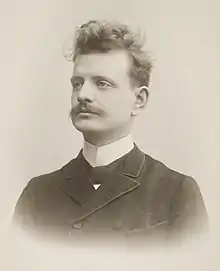Spring Song (Sibelius)
Spring Song (in Swedish: Vårsång; in Finnish: Kevätlaulu), Op. 16, is a single-movement tone poem for orchestra written in 1894 by the Finnish composer Jean Sibelius.
| Spring Song | |
|---|---|
| Tone poem by Jean Sibelius | |
 The young composer (c. 1895) | |
| Native name | Vårsång |
| Opus | 16 |
| Composed | 1894, rev. 1895 |
| Publisher | Breitkopf & Härtel (1903) |
| Duration | Approx. 8 mins. |
| Premiere | |
| Date | 21 June 1894 |
| Location | Vaasa, Grand Duchy of Finland |
| Conductor | Jean Sibelius |
History
The piece was initially composed as Improvisation for Orchestra, in the key of D major. It premiered on 21 July 1894 at an outdoor festival in Vaasa, organized by the Society for Popular Education (Kansanvalistusseura). Short, lyrical, and delicately scored, Sibelius's piece was ill-suited for the open-air concert, and the audience received it less enthusiastically than another work on the program: Korsholm, by Sibelius's brother-in-law and friend Armas Järnefelt. Shortly therefore, Sibelius withdrew Improvisation for revision. In 1895, he recast it in F major and retitled the work Spring Song (Vårsång), appending the subtitle "The Sadness of Spring" to that (unpublished) version.[1] This version of the tone poem premiered on 13 April 1895 in Helsinki.
Structure
The work is scored for 2 flutes (both doubling piccolo), 2 oboes, 2 clarinets (in B♭), 2 bassoons, 4 horns (in F), 3 trumpets (in F), 3 trombones, tuba, timpani, glocken, violins, violas, cellos and double basses.[2] Spring Song takes about 8 minutes to play.

The tempo marking is: Tempo moderato e sostenuto. The piece contains an optimism that is relatively rare among Sibelius' works. It is known for its prominent use of bells at the end of the song.[3]
Discography
The sortable table below lists commercially available recordings of Spring Song:
Notes and references
- Notes
- Refers to the year in which the performers recorded the work; this may not be the same as the year in which the recording was first released to the general public.
- P. Berglund–EMI Classics (5 69773 2) 1997
- C. Groves–EMI Classics (5 85532 2) 2003
- A. Gibson–Chandos (CHAN 8395/6) 1985
- N. Järvi–BIS (CD–384) 1988
- V. Sinaisky–Brilliant Classics (BC9212) 2010
- Neeme. Järvi–DG (00028947755227) yyyy
- O. Vänskä–BIS (CD–1125) 2000
- S. Sato–Finlandia (0927–49598–2) 2003
- O. Vänskä–BIS (SACD–1645) 2009
- L. Segerstam–Ondine (ODE 1112–2) 2007
- E. Gardner–Chandos (CHSA 5217) 2021
- S. Oramo–Chandos (CHAN 20136) 2019
References
- Erik Tawaststjerna (19 April 2012). Sibelius Volume I: 1865-1905. Faber & Faber. p. 142. ISBN 978-0-571-28717-8.
- Score, Sibelius: Vårsång (Frühlingslied), Breitkopf und Härtel, Leipzig, 1903
- Barnett, Andrew (2007). Sibelius. Yale University Press. p. 89. ISBN 9780300111590.
External links
- Spring Song: Scores at the International Music Score Library Project
- Johnston, Blair. Spring Song at AllMusic